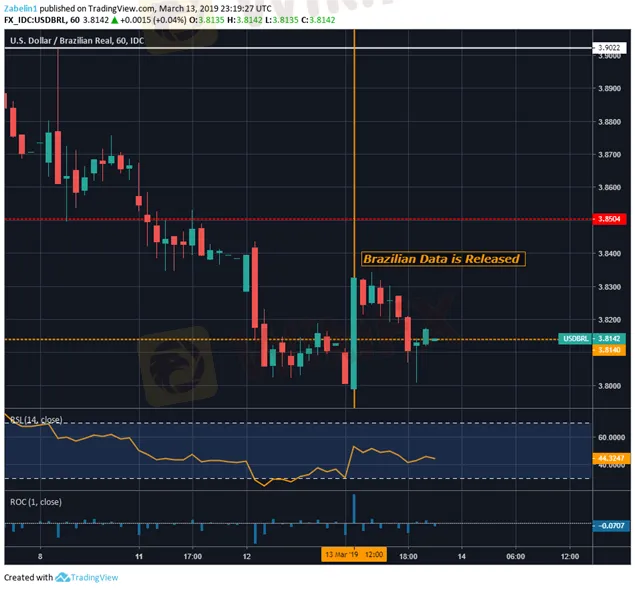简体中文
繁體中文
English
Pусский
日本語
ภาษาไทย
Tiếng Việt
Bahasa Indonesia
Español
हिन्दी
Filippiiniläinen
Français
Deutsch
Português
Türkçe
한국어
العربية
BRL Shrivels on Soft Industrial Production, Retail Sales in Sight
Abstract:The Brazilian Real suffered yesterday following the release of underperforming industrial production data. BRL traders are now focusing on upcoming local retail sales with an
BRL TALKING POINTS – USD/BRL, RETAIL SALES, BREXIT VOTE
BRL fell on soft industrial production report
Traders are now eyeing local retail sales data
Peripheral eye remains on Brexit as external risk
See our free guide to learn how to use economic news in your trading strategy!
The Brazilian Real wilted after year-on-year industrial production clocked in at -2.6 percent, undershooting the -1.5 forecast. After the data was released, USD/BRL rose almost one percent and closed higher that day at 3.8142, on the cusp of the 3.8140 resistance. Traders are now eyeing the upcoming year-on-year retail sales data with estimates showing an anticipated rise of 1.0 percent with the previous at 0.6.
USD/BRL – Hourly Chart
Economic data out of Brazil has been relatively weak as the country continues to struggle with a crippling fiscal deficit of 41.13 billion Reais. President Jair Bolsonaro has put together a bill which seeks to reform the bloated pension system and could see over 1 trillion Reais saved over the course of a decade. The first round of votes on the proposal will be held at the end of May in the lower house of Congress.
In Brazil, the economic docket remains relatively light for the rest of the week so most of the Reals price movement will likely be influenced by external factors. In the US, initial jobless claims and new homes sales are scheduled to be released which could see the Real fall or rise against the USD depending on the outcome and magnitude of the data.
Other risks from abroad include the Brexit debacle which has caused violent swings in Sterling as the outcome of the EU-UK divorce oscillates between optimistic and bleak. If the outcome results in investors seeking haven demand over yields, emerging market currencies – like the Brazilian Real – may take a hit. This would then only add to the growing list of risk-aversion-inducing triggers that already hang over investors minds.
Disclaimer:
The views in this article only represent the author's personal views, and do not constitute investment advice on this platform. This platform does not guarantee the accuracy, completeness and timeliness of the information in the article, and will not be liable for any loss caused by the use of or reliance on the information in the article.
Read more

Key Economic Calendar Events for This Week
This week's key economic events include German retail sales, M3 money supply in South Africa, retail sales in Switzerland, and key rate decisions from the Federal Reserve and the Bank of England. The U.S. will also release its Nonfarm Payrolls, unemployment rate, and ISM Manufacturing PMI. These events are crucial for gauging economic health and guiding currency valuations.

Week Ahead Spotlight: CPIs, Retail Sales, RBNZ Rates!
In March, Canada's consumer price index increased by 0.6% compared to the previous month, surpassing the 0.3% growth seen earlier. In April, the Reserve Bank of New Zealand opted to maintain its official cash rate at 5.5 percent for the sixth consecutive meeting, emphasizing the ongoing need to address inflation fully. In March, the UK Consumer Price Index registered a slower-than-anticipated increase, reaching 3.2% in annual terms, down from the 3.4% rise observed in February. In March, UK...
Brazil's coronavirus cases likely 12 times higher than reported - Business Insider
Official tallies have recognized 23,955 cases of COVID-19 and 1,361 resulting deaths. Researchers say there could be more than 280,000 cases.
Tim Cook says Apple will be donating to help preserve the Amazon in the wake of devastating forest fires
Apple CEO Tim Cook says his company will donate to help preserve the Amazon after fires have ravaged its forests.
WikiFX Broker
Latest News
SQUARED FINANCIAL: Your Friend or Foe?
Big News! UK 30-Year Bond Yields Soar to 25-Year High!
High-Potential Investments: Top 10 Stocks to Watch in 2025
Why Is Nvidia Making Headlines Everywhere Today?
Discover How Your Trading Personality Shapes Success
US Dollar Insights: Key FX Trends You Need to Know
FINRA Charges UBS $1.1 Million for a Decade of False Trade Confirmations
BI Apprehends Japanese Scam Leader in Manila
Bitcoin in 2025: The Opportunities and Challenges Ahead
Join the Event & Level Up Your Forex Journey
Currency Calculator






